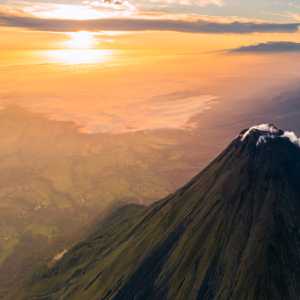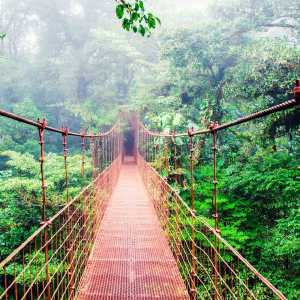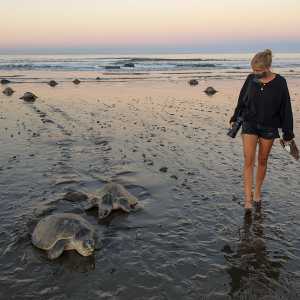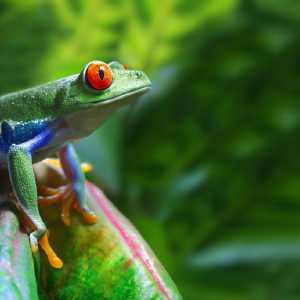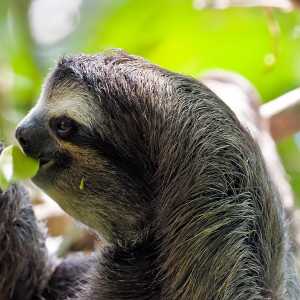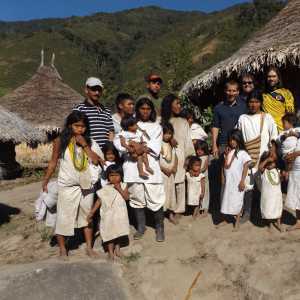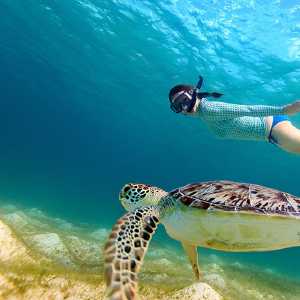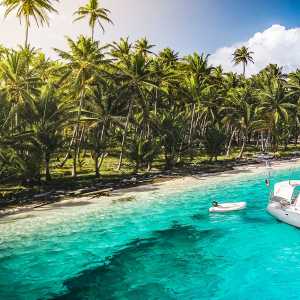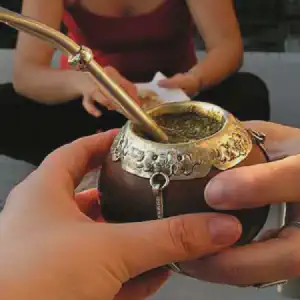Costa Rica family holiday 15 days
Costa Rica family holiday 15 days
Day 1: San Jose. Welcome to Costa Rica! You can arrive at any time today as there are no activities planned. San Jose sits in the heart of the country in the lush, wide Central Valley, and has a comfortable subtropical climate. With over half the country’s population living within its limits, it’s a bustling city with lively markets, intriguing museums and a dynamic atmosphere. It’s also easy to navigate – laid out in a grid pattern, the avenidas run east to west and the callés run north to south. After the meeting tonight, perhaps get to know the rest of the group and head out for your first taste of the local ‘tico’ food.
Day 2: San Jose . Today you’ll get a taste of the sights in and around San Jose when you meet you leader and group at a group meeting at 7:30am. After this meeting you will hop on a bus for a guided tour. Your first stop will be the National Museum, which offers an introduction to Costa Rican history with some fascinating displays of artefacts from Pre-Columbian, colonial, and early republic time. The building itself also tells a story – housed in an old fort, there are bullet holes from the 1948 civil war on the outside. Continue on to ‘INBio Park’, an educational and recreational centre at the National Institute of Biodiversity. Here you’ll get an idea of Costa Rica’s incredible wealth of plant and animal species – walk through various rain forest habitats, spotting iguanas, sloths, birds, and many plants with very unique adaptations. There are also tarantula, butterfly, snake, and frog exhibits. Next, drive out of the city to Doka Estate (approximately 1 hour), which sits on the fertile slopes of the Alajuela Poas Volcano. Take a tour of the coffee fields and plantation sugar cane mill. The estate is home to some of the best coffee in Costa Rica (they might say the world), and you’ll learn all about going from seed to cup. You’ll also experience a kaleidoscope of fluttering colour at the butterfly farm, before returning to San Jose.
Day 3: Tortuguero National Park. Say goodbye to San Jose early this morning and head out into the Costa Rican wilderness. Travel out of the city, stopping for breakfast en route, before boarding a launch to navigate the waterways into the Tortuguero National Park (approximately 2 hours). There are no roads to your accommodation and this isolation makes the park a nature lover’s dream. You’ll travel along Los Canales, which were dug during the 1960s to connect the coastal lagoons to a maze of natural channels in order to transport lumber by boat. They now form a long highway (100 kilometres) through dense rainforest. As you motor along the river, every now and then you’ll see a clearing in the thick-forested banks, where settlers eke out an existence from slash-and-burn agriculture and fishing. Everyone fishes here – an iridescent flash will mark the flight of a kingfisher, while anhinga and several species of heron can be seen perching in the shadows along the water’s edge, waiting to strike. Your accommodation for the next two nights is a riverbank lodge that stands among Caribbean rainforest. Here you can rest up, delight in some home comforts and relax poolside. Maybe take a walk to the village and on to the beach, then fall asleep to the unearthly cry of the howler monkey.
Day 4: Tortuguero National Park. There’s no need for alarm clocks in this part of the world, and you’ll wake this morning to the screech of toucan and oropendula. This is just the beginning of your wildlife-filled day – you’ll go on excursions by boat and on foot, soaking up Mother Nature’s most flamboyant floral and fauna displays, using the experienced eyes of the boatman or guide spot the animals. Tortuguero National Park, established in 1970, is home to 13 of Costa Rica’s 16 endangered mammals. Among them are manatees, ocelots and jaguars, as well as over 300 bird species. First and foremost, however, it is the nesting ground of the green turtle, which comes ashore between July and October to lay its eggs on the sandy beaches. This area has long been associated with the catching of turtle (tortuguero means turtle-catcher), and the original indigenous inhabitants used turtles as a sustainable resource, but the arrival of Europeans led to major exploitation. Lesser numbers of the critically endangered hawksbill turtle, plus loggerheads, and giant leatherback turtles also nest within the park at different times of year. Just some of the other animals you might see today are tree frogs, sloths, caimans, crocodiles, iguanas, spider monkeys and white faced capuchins, making this an unforgettable natural journey. Notes: If you visit between August and October and are interested in the nesting ground of the green turtle, it is necessary to wear dark colours.
Day 5: Sarapiqui. After breakfast, wave goodbye to the tree-swinging howler monkeys and transfer by boat back to the port (approximately 2 hours) – keeping your eyes open for more animals and birdlife that line the waterways. Then you’ll head to another region rich in biodiversity and beloved by birdwatchers – Sarapiqui. Pass palms (used to produce palm heart), banana and papaya growing on the edge of the roadside along the way (approximately 2 hours). Stop for lunch and for some leg-stretching time, before continuing to your destination (approximately 1.5 hours). On the banks of the Puerto Viejo River and next to the Braulio Carrillo National Park, the budding town of Sarapiqui is surrounded by virgin forests, banana and pineapple plantations. Sarapiqui is also known as one of the richest areas in Costa Rica for bird watching. The diversity of lowland bird life is incredibly impressive. A biological research station and several nearby forest lodges have made this undisturbed habitat accessible to scientists and travellers. For the next two nights you’ll stay in a family-run eco-lodge surrounded a reforested area with native trees, an old-growth forest on the banks of the nearby river, and tropical gardens bulging with flowers and fruit. The rest of the day is free to relax and enjoy this beautiful area, maybe just swinging the day away in a hammock.
Day 6: Sarapiqui. Today is a free day, so how you explore the lush, tropical surrounds of this idyllic location is up to you and your family. There are so many activities on offer for you, but the first choice of many families is the exhilarating fun of battling the gushing rapids of the Pacuare River on an optional full day rafting trip. The level of rafting here is very suitable for families, but please note that the minimum age is 8 years old. After a safety briefing and getting you kitted out with a snazzy orange vest, you’ll work as a team to make your way through increasingly challenging rapids with names like ‘Terciopelo snake’ and ‘Double drop’. Along the way, you’ll also have opportunities to spot wildlife and see waterfalls in the lush forest. For some less active water-based fun, you could take a relaxing boat trip and perfect your nature spotting skills. If you’d prefer to stay on land, you can saddle-up for a horse ride, or make for the forest trails (like those in La Selva Biological Station) by foot. For something completely different, maybe satisfy your sweet tooth on a chocolate tour, opening the secrets and wonders of one of mankind’s favourite foods.
Day 7: Arenal. Today you’ll cross west through the north of the country to Arenal (approximately 2-3 hours) where you’ll lay eyes on a storybook volcano that soars out of the verdant plains. The Volcán Arenal shoots up to 1,633 metres in a perfect cone, and looks a lot like what would pop into your head if you were asked to imagine a volcano. The scenery is made up of primary cloud forest and rainforest, and this is a land of rivers, lakes and, thanks to the volcano’s inner workings, a number of thermal springs where hot, lava-heated water gushes to the surface. These springs have been turned into a number of thermal pools and waterfalls, often surrounded by dense foliage, offering ideal place to relax. Your accommodation for the next two nights has lots of activities on offer, as well as something you wont get in many other places in the world – the chance to relax by a pool with a view of a towering volcano! The much-loved famous volcano isn’t spewing lava every day and night like it used to, but it is still rumbling and puffing out plumes of gas. Maybe while away the day at the accommodation’s own thermal hot springs.
Day 8: Arenal. This morning you’ll head out for a guided tour in Arenal National Park, where the trails pass through interesting dwarf cloud forest, and the rich bird life includes several species of hummingbird and Costa Rica’s national bird (the clay-coloured robin that’s renowned for its melodious song). The afternoon is then free for optional activities in the local area. To get a closer view of the majestic peak, take a hike up towards to the volcano, through old lava flows and with views of the lovely Lake Arenal. Otherwise, you could get a different panorama of the summit by soaring smoothly through the rainforest on the slow paced Sky Tram. At an observation platform you can then enjoy magnificent views of the Arenal Volcano’s southern face. Getting down is even more exciting – return the way you came, or jump on a fast-paced zip line and fly down the mountain. Heading further afield is La Fortuna Waterfall, where you can take a short hike to the thundering cascade, then take a refreshing dip in a nearby clear swimming hole. A day trip to Cano Negro is also an option – this wildlife refuge is full of migratory and resident birds as well as river wildlife, both mammals and reptiles. Horse riding is also available in the Arenal area, and don’t forget about the thermal waters that will wash away your pains and worries.
Day 9: Monteverde. Travel along the Arenal Lake – a famous hangout for avid windsurfers – via Tilaran to Monteverde de Santa Elena (approximately 4-5 hours). Enjoy great views across the lake back towards the Arenal Volcano, and stop on the roadside for great homemade cakes and refreshments. Climb to Monteverde, feel the climate cooling and see the vegetation change from tropical to cloud forest. The surrounding hills are scattered with fair-trade co-operative coffee plantations, famous for producing some of the best coffee beans in the country. In the afternoon there may be time to visit a colourful butterfly farm (optional). Monteverde was founded in 1951 by a group of North American Quakers, who originally cleared virgin forest to create verdant pastures ideal for dairy farming. These environmentally aware settlers soon became conscious of the danger that unrestricted settling and farming could cause to this precious habitat, and so they established a small privately-owned wildlife sanctuary. This has since grown to become the internationally-renowned Monteverde Cloudforest Biological Preserve. Cloud forests are similar to rainforests, but instead of relying on rain for essential moisture, the water comes from the semi-permanent cloud that covers the region. That make it lush, full of wildlife, and truly a nature lover’s paradise. More than 2,000 species of plants, 320 bird species and 100 different types of mammals call Montverde home. You’ll have lots of time to discover the natural wonders here.
Day 10: Monteverde. Today everyone will become an ornithologist as you explore a forest that’s home to the Resplendent Quetzal (one of the most reclusive birds in the world), the blue-crowned motmot, the emerald toucanet and some 30 species of iridescent hummingbird – and that’s just a few of the 400-odd bird species recorded here! It’s not only things with wings that live here – more than 100 mammal species, 1,200 amphibian and reptile species, and many thousands of insect species are found here, in addition to an amazing variety of plant life. Appropriately in a place so filled with birdlife, one of the highlights for many is the chance to get a bird’s eye view of the forest up the canopy, instead of always looking up into the trees. As an included activity, you’ll walk across hanging bridges (Sky Walk) suspended through the trees. It’s not designed for vertigo suffers, but provides a fantastic chance to get in amongst the foliage and experience the forest from a great vantage point. Monteverde also has loads of other optional activities to get stuck into – watch winged, coloured jewels of the forest in the Butterfly Garden and the Hummingbird Gallery, gallop through the forest on a horse, visit an orchid farm, or whizz through the forest on ziplines between the trees on the thrilling ‘Sky Trek’. There might also be the option to hike through the forest as dusk, watching all the nocturnal creatures begin to stir.
Day 11: Manuel Antonio National Park. Departing Monteverde, descend to the Pan-American Highway, which you’ll follow southward across the flat coastal plain. Your journey takes you along a coastline of fine sand beaches, separated by the occasional area of mangrove and endless plantations of African palm. Your journey ends at Quepos, a sport-fishing centre and the gateway to Manuel Antonio National Park (approximately 6 hours plus stops). The Spanish explorer Ponce de Leon first documented this area in 1519 during his (unsuccessful) search for the Fountain of Youth. Your accommodation is near the Pacific Ocean and the tropical forest, and part of the property has been officially declared a Wildlife Reserve thanks to its biodiversity in plant species and fauna, such as spider monkeys, sloths, coati, and armadillos. Soak up some rays and relish the spoils of this unique beach setting, where lush rainforests sprawl gently towards the sand and white-faced capuchin monkeys peer cheekily from the treetops.
Day 12: Manuel Antonio National Park. Manuel Antonio National Park stands south of Quepos on the shores of the Pacific. Incorporating 12 small islands scattered just off the coast where migrating whales can sometimes be observed, the park is home to hundreds of mammal and bird species in a region of lagoons and fertile mangrove swamps. We take the 1.5 hour drive to the national park where you’ll enjoy a three-hour guided walk along the trails within the park and have plenty of time to relax on one of the idyllic palm-lined bays. The turquoise seas are perfect for swimming, kayaking, sailing or fishing. It would be easy to spend your whole time here in, or by, the water.
Day 13: Manuel Antonio National Park. Enjoy another day at your leisure to explore the area. There are plenty of opportunities to join optional activities or simply relax and enjoy the hotel facilities. Your leader will be there to give you a run down of the options and lend you a hand. For those that love the water, you could take a catamaran tour out to hidden beaches, looking out for dolphins, snorkelling in the warm waters, jumping off the top deck, and luxuriating in a Costa Rican sunset. For something a bit more active, then paddling a kayak along inlets and small islands to secluded sandy beaches is just the thing. Back on land, there’s amusements like tennis or mini-golf at the accommodation, or you could horse ride and zipline, taking in as much of this incredible natural environment as possible, before you leave it behind and return to city life tomorrow.
Day 14: San Jose. Retrace your steps northward along the coastal road to San Jose, stopping en route at Carara Biological Reserve. Here you’ll walk for two or three hours through the rainforest in the hope of seeing the beautiful, rare scarlet macaw, as well as the tiny black and green poison dart frog. Carara’s position between the dry tropical forest of the north and the wet rainforest of the south means it’s blessed with a uniquely high diversity of plants and animals. Continue on from Carara, where the route turns inland to follow the main Pacific Highway through the agricultural towns of Orotina and Atenas. You’ll then arrive back in San Jose for your final night (total driving approximately 5 hours plus stops). Before you finish up your trip, be sure to hit the city’s colourful and lively markets for some last-minute souvenir shopping, then get the group together to celebrate the end of this family adventure with one last Costa Rican meal.
Day 15: San Jose . This Costa Rica holiday comes to an end today. There are no activities planned for the final day and you are able to depart the accommodation at any time.Private / Group




